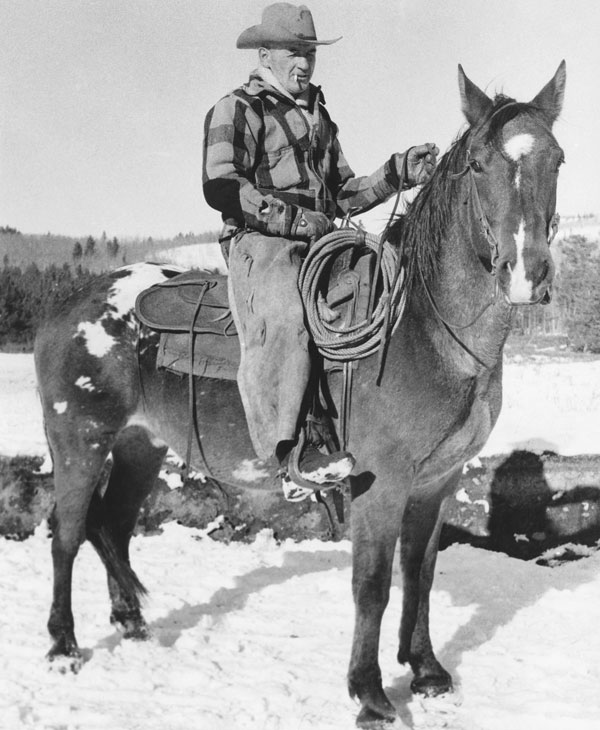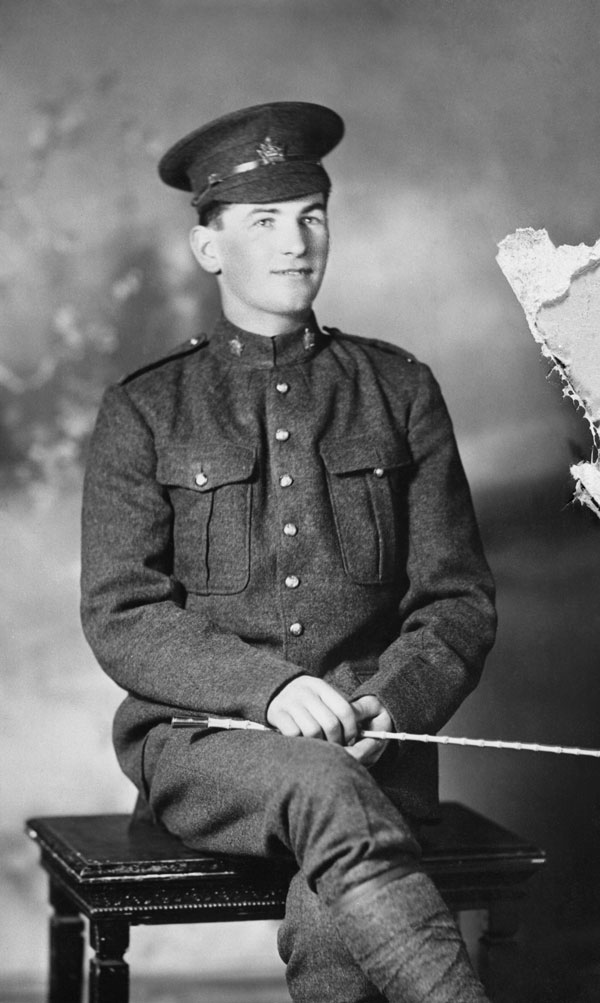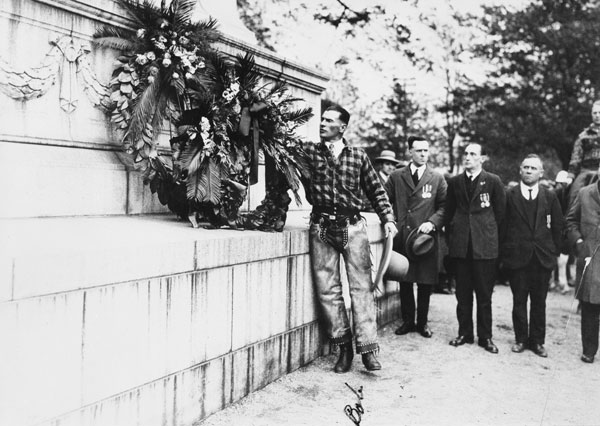
Bob Carry was described as a man of sterling qualities, a “Cowboy” in the true sense of the word — a working cowboy, who throughout his life exemplified “mind over matter” to the very highest degree, and the squarest shooter that ever lived.
Bob was born on a farm at Morden, Man., in 1894. Two years later his father died, and in1903, his mother came to Alberta bringing her five children; Lilly, Slim, Bob, Jim and Minnie.
Mrs. Carry took up a homestead about 25 miles east of Nanton. It was necessary for some of the children to get out and shift for themselves at an early age, so in the spring of 1908, Bob, at 14, was herding horses for ranchers Oldenburg and Charlie Dawson down the Little Bow River.
Due to homesteaders fencing up the range, Dawson decided to move to Manyberries. In the spring of 1909 he pointed his trail herd east.
To quote from Bob’s memoirs: “I sure put in the hours. Being the kid of the Outfit, I was kept going a little more than the rest of the gang. If I came in early or late for grub, I was met at the door by the cook with two big water buckets. I believe that was what made me bow-legged — packing water for that cook.
“Part of my job was to jingle the horses in the morning and have them in before daylight. The foreman, Dave Wilson, used to catch a horse every day for me to use the next morning. It just seemed he would just catch anything that was handy, and most of the time I never got a look at the horse till I pulled my saddle off after corralling the ponies. They were always gentle until one morning that fall when it was cold and pitch dark, I had a quite a time to get my rope on the horse that was there for me. If he had not snorted I never would have got him. I had to throw at the noise.
“He had an awful hump in his back, but I finally got my saddle on him. He acted so snakey that I got on him in the corral with the gate shut. That is, I started to get on him, but just found a hard spot in the corral, I think I went right over him. He bucked me off five times and the next time just walked off like an old horse. Just sick of it, I guess. Anyway, when I brought the horses in the foreman asked how the horse went. I told him he went fine. He said, ‘don’t turn him loose, I believe I’ll ride him myself today.’ When we came out after breakfast he threw his saddle on him and climbed up and came down again, bucked off right on his head. It sure did me good, and the boys kidded him about getting bucked off the kid’s jingle horse.”
The New Year found Carry working on a small outfit at Eight Mile Lake north of Coaldale. The following spring, he broke horses and that fall he and George Campbell trailed a bunch of their horses to the Athabasca River, 125 miles north-west of Edmonton, where they spent the winter trapping. Riding back south in the spring, he broke a few horses around Aldersyde and then went to work for Specky Anderson at Millarville.
Pat Burns, who had purchased the Quirk Ranch near High River in 1910, bought the Specky Anderson cattle in the spring of 1913. Bob went along with the cattle and worked for Jack Dempsey, who was running the outfit.
Bob stayed with Dempsey till the fall of 1915, when he enlisted with the 89th Battalion in Calgary and spent the winter training as a member of the “Nonpareils.” The next spring, Albert Nimmons staged the Veterans Stampede in Calgary as a benefit. Held on Good Friday in 1916, Bob Carry won first place money on a bronc called Boxer.
During the latter part of May, the Battalion left for England. After leaving Salisbury Plain as a member of the 31st, Bob took part in the Battle of the Somme. He was seriously wounded the first time ‘Over the Top’ [out of the trenches] when he was hit above the knee on his left leg by the nose cap of a big shell. Making a tourniquet out of his puttee twisted up with his bayonet, he stopped the bleeding — and then cut off his shattered leg with his knife.

Bob remained conscious for 25 hours until he was picked up, and he then passed out. After three days in France, he was moved to a hospital in England. Gangrene had set in, and he had 17 amputations before the gangrene was stopped, leaving him with barely four inches of bone from the hip joint.
While convalescing in the hospital, Bob figured out how he could ride with his artificial leg. He arrived back in Calgary in September of 1917.
To quote again from Bob’s memoirs: “The day after I got home, Dempsey held my ol’ top horse, Rags, until I got up, and I sure had one hell of a time getting there. The old horse seemed to know that I was not much good anymore, for he stood like a rock, and that was something he had never done before.
It was not long before I could get along pretty well with a horse again. I rode for Dempsey till the spring of 1919 when I started to work for the Sheep Creek Stock Association, running their cattle on the Forest Reserve. I had homesteaded in 1912 right against the Reserve, so I stayed home and worked for the Association for 10 years. I worked into a little bunch of horses and cattle of my own and used to break a few horses for myself.”
Buck George, who worked for Bob, said he was a horse-lover and a real horseman who liked to ride big horses, ones that were good walkers. On the Association horse round-ups, he was always well-mounted, and few could follow him. He had a wonderful sense of rating his horse to get the most out of him. Riding through the poplars at breakneck speed, he saved his good leg as much as possible and let his wooden leg, resting in the hobbled stirrup, hit the trees. The hair on his chaps was worn off more on the left leg. After a day’s ride, his underwear would be soaked with blood where the socket of his artificial leg had gouged into the remnants of his thigh, but he never complained.
To brand his colts, he would rope a colt by the neck, take a wrap on a corral rail, work his way up to the colt, grab it around the neck, drop his rope and dog it down. He would then take the rope off the colt’s neck and hog-tie it.
Pat Nichols recollects him buying two carloads of cows in the Calgary yards. Approaching Carry’s place, he saw something going on in the corral. He stayed back and watched Bob neck a cow, back his horse into a corner, mount a second horse, heel the cow, stretch her out, and then dismount and dehorn her. It was getting toward noon, and most of the cows had been worked over that morning.
On one of the occasions when he wrecked his wooden leg, Bob was a little late for a friend’s wedding. That was due to the fact he had to whittle out a new foot before he could leave home.

In 1926, Bob and Pat Nicols formed a partnership to run the Black Diamond Stampede, which carried on for 20 years. The summers of 1926 and 1927 he was hired by Peter Welsh, who ran the Alberta Stampede Company, to act as one of the judges. He then started judging the bucking horse riding at the Calgary Stampede in 1929, and continued to for nearly 20 years. Sheppard was told, “No fairer judge ever marked a card.”
In 1940 Bob married Eileen Thom, and they had two daughters. In 1941, he was elected Councillor to the Municipality of Stockland and became a Councillor in the M.D. of Turner Valley when the two were amalgamated in 1944. He served the Foothills District in like capacity for about 10 years, until his retirement.
Quoting from his memoirs: “While at the Quirk Ranch I believe was the best part of my life, everything seemed to go so smoothly. Lots of work but a good bunch to work with and lots of fun branding and weaning calves, always some snakey cow to put the bunch on foot on the fence. Good horses to ride and lots of them, and enough colts to break to keep a man in practice.”
Bob Carry, after living a full and useful life, passed away June 15, 1966. He was buried at Millarville by a host of cowboys congregated to pay their respects to one who served his country well and a man they all believed to be “the squarest shooter that ever lived.” Rags, his ol’ top horse of World War I days, lived to be 33 years old.
Condensed by Terri Mason
